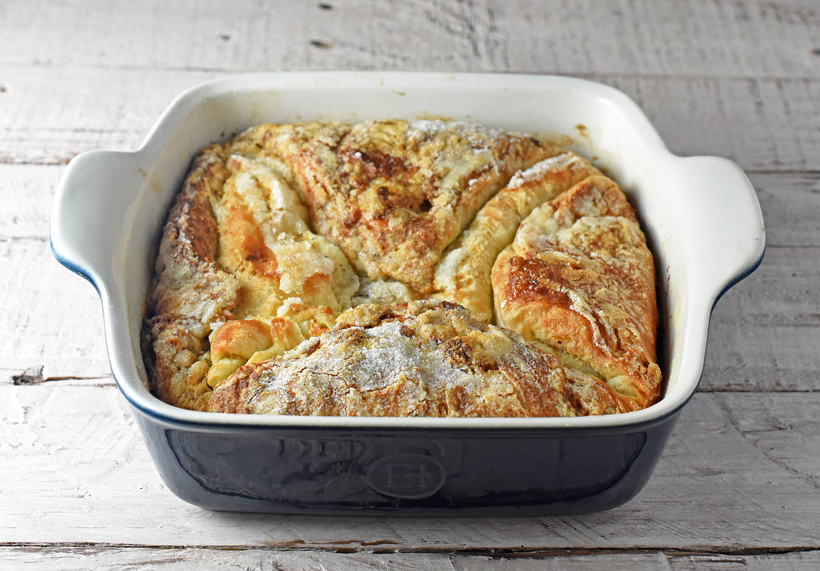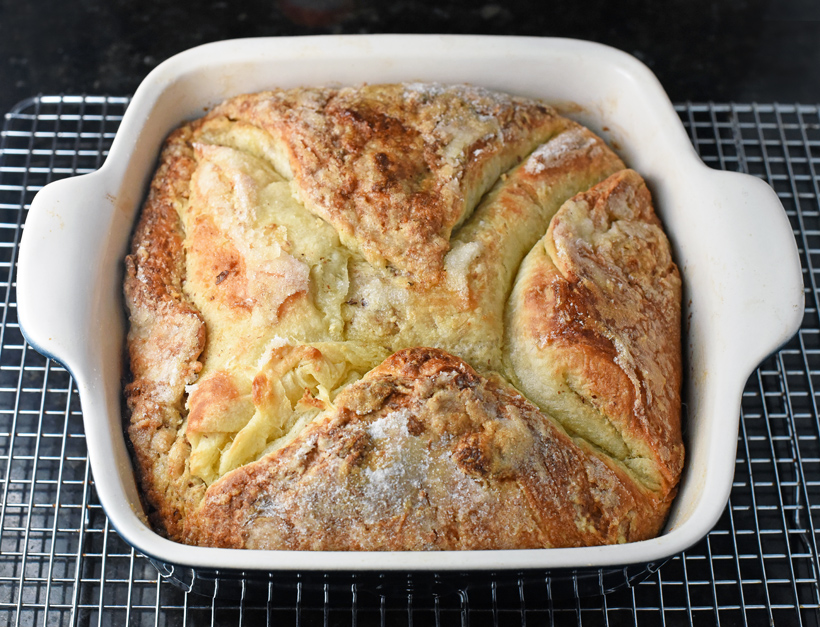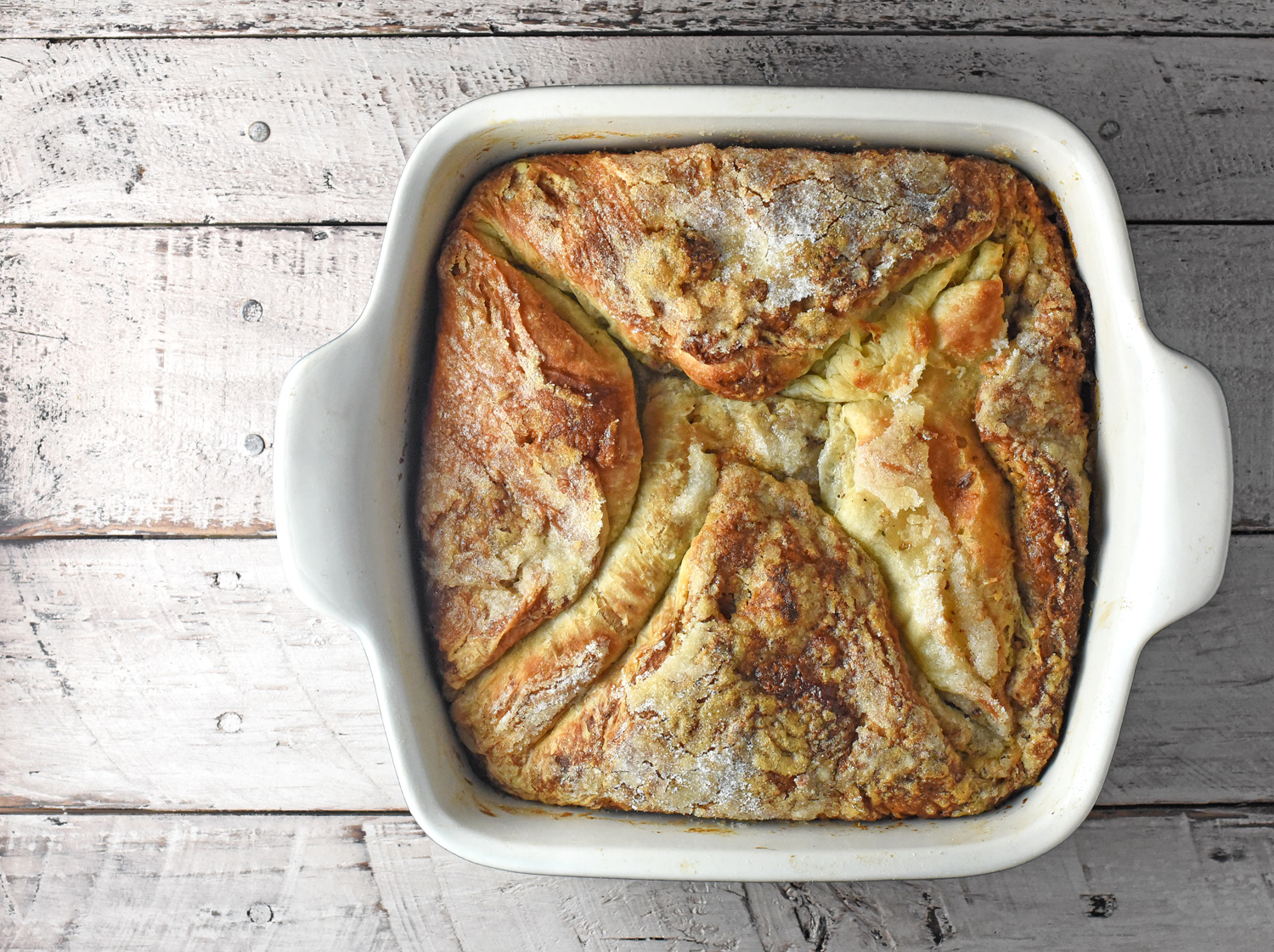I love baklava. The thin, nutty layers saturated with fragrant syrup take me back to a warm night in a caravanserai in Baku’s Old City, drinking herbal tea and dark Azerbaijani cognac. Or to the mountains of northern Azerbaijan, where locals make their unique Quban baklava, paper-thin latticed layers finished with in bright red. Or to the terrace of an Ottoman house in ancient Berat in Albania, where Turkish occupation has left its marks upon culinary traditions.
I’ve already forayed into baklava territory with my Caucasian Plombir-Apricot Baklava Sundae, although the sweet pastry there was merely store-bought. There are some great recipes out there. Check out Feride Buyuran’s Pomegranates and Saffron for a Baku-style pakhlava, or Mirjam Letsch’s Street Food Kosovo for a typical Balkan bakllavë. But the time has come to create my own.
So what makes a baklava a baklava? Layers of dough (usually brushed with butter), nuts, and syrup. A cup of tea doesn’t hurt either. What added value can I possibly bring to such a simple but delectable treat? Should I expatiate on the best syrup recipes (honey, saffron, or rose water)? Show you how to make your own phyllo dough from scratch, keeping you busy on rainy days? Give you a grand tour of all the baklava variations from Ljubljana to Tashkent?
No. Instead, I will claim my little slice of the world baklava pie by creating my own variation: the baklav’amann.

The baklav’amann, aka Food Perestroika’s signature baklava, is a cross between a normal baklava and a kouign-amann. The latter, a Breton cake made with bread dough and layers of butter and sugar folded in (kouign means cake in Breton, and amann means butter), has gained popularity outside of its native Brittany in recent years. Dominique Ansel, of cronut fame, is probably the instigator of the movement, selling individual kouign-amanns at his bakery since its opening in 2011. You can find Ansel’s recipe here.
Kouign-amann may not contain nuts, but being made from a laminated dough, it’s a layered sweet pastry — just like regular baklava. It also shares the same fondness for butter and sugar, even if the proportions are different. The two were meant to be combined! The original kouign-amann recipes call for flour-sugar-butter ratios of 40-30-30, and only now do I realize that the ratios I’ve ended up with are almost exactly that, if you ignore the nuts and convert the honey to an amount of sucrose of equivalent sweetness.
Just as you would drink a cup of tea with your baklava, I’m serving mine with a black tea ice cream. It always surprises me that people in baklava countries, where hot summers regularly send the mercury shooting above the 37 C / 100 F mark, don’t eat more ice cream. My recipe is adapted from Frozen Desserts, as usual, with some hydrocolloids added — xanthan gum and gellan, both from Modernist Pantry — to give it a chewy texture (and act as stabilizers). Soaking the tea leaves in cold milk overnight produces a flavor that’s free of the bitter tannin released when the leaves are steeped in boiling liquid.
I’m using Lercari’s Spun Honey from Straight from the Hive and Samovar black tea from Kusmi Tea, both of which have pretty strong flavors in their respective categories. You can of course choose your own brands and producers, but I’d recommend sticking to a spun, or creamed, honey (which is easier to spread) and a smoky black tea.

Black tea ice cream
Yields about 8 servings (400 g)
265 g whole milk
7 g loose black tea leaves
90 g sugar
40 g egg yolks
0.9 g xanthan gum
0.25 g gellan
225 g heavy cream
- Combine the milk and tea leaves in a plastic container. Cover and refrigerate overnight.
- Strain the milk through a colander, pressing on the tea leaves to extract as much flavor as possible.
- In a small saucepan, bring the milk and half of the sugar to a simmer, then remove from the heat.
- In a bowl, whisk the egg yolks, xanthan gum, gellan, and the remaining sugar to a pale ribbon. Slowly add the milk mixture, beating constantly.
- Return to the saucepan, and cook over very low heat to 85 C / 185 F, stirring constantly. Transfer to a container over a bowl of ice water, and let cool.
- Stir in the heavy cream, then refrigerate for at least 4 hours.
- Chill the mixture in the freezer for 30 minutes.
- Churn in an ice cream maker, following the manufacturer’s instructions. Transfer to the freezer for at least 8 hours before serving.

Baklava
Yields 8 servings
3.5 g active dry yeast
150 g lukewarm water
250 g bread flour, sifted
8 g salt
100 g superfine sugar
50 g walnut meal
50 g almond meal
180 g butter, softened (plus a little bit to grease the baking dish)
100 g creamed wild flower honey
- Mix the yeast with 1/3 of the water, and let rest for 5 minutes.
- In the bowl of an electric mixer fit with the paddle attachment, mix the flour and salt on medium speed. Add the remaining water, and mix well. Add the yeast mixture, then mix for 5 minutes. Cover the dough with plastic wrap, and let rest for 20 minutes.
- In a bowl, mix 3/4 of the superfine sugar with the walnut and almond meals.
- Roll the dough to a 26 cm square. Spread the butter on top, leaving 3 cm clear on all sides. Fold in 3, like an envelope, gently pinch the edges to seal, and give a 1/4 turn. (In this step and all the next ones, even if the filling spills out, don’t try to fix it by folding the dough again, as that would mess up the layers! If you look at my pictures, you clearly see neatly stacked layers. Random folds result in big doughy chunks. At most, sprinkle a little bit of flour to prevent the grease from sticking to your rolling pin too much.)
- Roll slowly back to a 26 cm square on a well-floured surface. Make sure that the folds remain even — as you’re rolling, the top fold may tend to slide and become smaller. If this happens, just pull it back to its original position. It’s very important to get these layers as perfect as possible so that the filling (which we’ll be adding next) is evenly distributed. Using an offset spatula, spread 1/3 of the honey over the dough, and sprinkle with 1/3 of the nut mixture, still leaving 3 cm clear on all sides. Fold in 3 again, gently pinch the edges to seal, and give a 1/4 turn. Refrigerate for 30 minutes.
- Repeat the previous step twice, without refrigerating the dough.
- Roll back to a 26 cm square. Fold the four corners in towards the center, leaving as small a gap between each edge as possible, but also avoiding overlaps.

- Grease a 20 cm x 20 cm square baking dish with butter. Place the baklava inside, folds facing up. Cover with plastic wrap, and let rise in a warm place for 45 minutes.
- Sprinkle with the remaining sugar, and bake in a 190 C / 375 F oven for about 35 minutes, until the internal temperature of the baklava reaches 100 C / 210 F everywhere.
- Let the baklava cool in the baking dish, cover with foil, and keep at room temperature.
Assembly
Yields 8 servings
black tea ice cream
baklava
- Take the ice cream out of the freezer about 15 minutes before serving.
- Cut the baklava into 8 (4 x 2) rectangles. You can either serve it at room temperature, or reheat it slightly in the oven.
- On each plate, serve one piece of baklava and one scoop of ice cream.



1 comment
Looks amazing!! 🙂